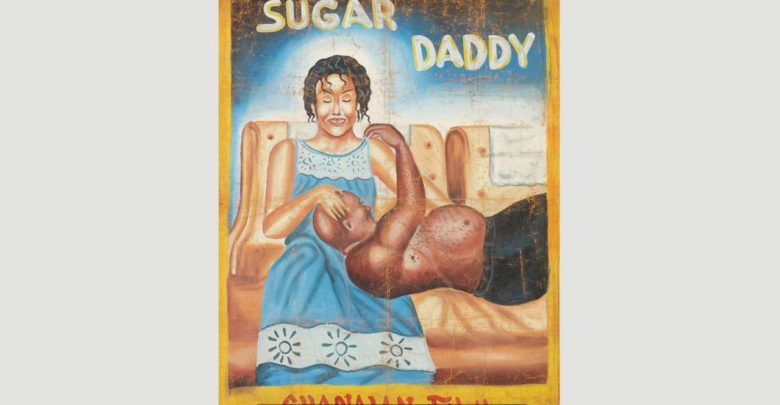
“They’re not just film posters – they’re 2m-high, one-off, original oil paintings,” says Karun Thakar, the collector and curator behind African Gaze, an exhibition showcasing film posters from Ghana.African Gaze features more than 100 posters – from the late 1970s to the early 2000s – that served as hand-painted billboard posters and were displayed in public spaces, such as roadsides and markets. They advertised mobile video club screenings of Hollywood, Bollywood, Nollywood and Ghanaian films.
Fantastical creatures, action, blood and guts seem to be common tropes in Ghanaian film posters of this era – but golf?
The posters are often gruesome and gaudy, turning up the dial on the film’s themes to eleven: Jurassic Park features a freakish dinosaur gobbling up a man and a person playing golf, indicating that the artists painting these posters might not have seen the films, while the poster for Total Recall depicts a Martian woman with three breasts who appears in just one scene.
Some posters hone in on details from single scenes
Graphically, the posters were designed to quite literally command attention and entice people to come and see the films being screened by mobile video clubs such as Princess Osu and Pal Mal Video Club, who would load VCRs, diesel generators and projectors into trucks and take the latest films to communities without access to cinemas. Artists seemed to love emphasising muscles and muscle mass, to the extent that Nyen Kumah’s poster foregrounds Jean-Claude Van Damme’s muscles more than the actor’s face
Artists seemed to love emphasising muscles and muscle mass, to the extent that Nyen Kumah’s poster foregrounds Jean-Claude Van Damme’s muscles more than the actor’s face
Close inspection of many of the posters reveal that screenings often took place at 8.30pm and cost 300 cedis. “It was business,” explains Thakar. “Entrepreneurs wanted their screenings to be sold out, and after the screening the posters would be rolled up and unrolled in the next village to advertise another screening – Princess Osu were known to use good artists and would pay the artists above the going rate.
Many of the posters are grotesque, grisly and gruesome: artists Joe Mensah and Nyen Kumah say their posters were deliberately extreme to ensure a full house
”Because they were paraded outdoors, paper wasn’t suitable; instead sacks of flour were flattened out, stitched together and repurposed as canvasses for the oil and acrylic paintings. “If you look closely, you can see the flour brand and 50kg underneath the painting advertising the film,” says Thakar.
Snakes are a very common motif of Ghanaian, Nollywood and Bollywood films; this poster shows a shaman trying to rid a person of a spirit possession
The posters are, in effect, a visual time capsule and reveal much about Ghana and West Africa as the 20th Century ticked over into the 21st. Some of the Nollywood and Ghanaian film posters, such as Power to Power, highlight a tension between modern Western Christianity – introduced by colonialism – and local faiths and belief systems, with a European Christ saving a demonic, possessed woman.
This Nollywood film highlights a tension between folk faiths and beliefs and Western Christianity
Equally, the presence of Bollywood posters highlights the popularity of mainstream Hindi cinema, pointing to a global cosmopolitanism. “When I walked around markets in Ghana, I was always struck by people singing popular Bollywood songs,” explains Thakar. “I grew up with Bollywood, and these posters show Bollywood’s family stories, dance, drama, overacting and melodrama were popular with local audiences.” The 1978 Bollywood film follows an Indian man – played by Dev Anand – who goes to the UK to seek riches only to become exploited and trapped
The 1978 Bollywood film follows an Indian man – played by Dev Anand – who goes to the UK to seek riches only to become exploited and trapped
“Ghost-ma films, where a mother dies and her spirit comes back and protects her child through an animal, seem popular; there’s Nagin Aur Suhagan, in which the mother comes back as a snake. Snakes and serpents feature heavily across Nollywood and Ghanaian film posters – we had to make a conscious effort to make sure there weren’t too many snakes in the exhibition,” continues Thakar.
A Bollywood film in which a mother dies and her spirit returns in snake form to protect her child
He can attest to the posters’ arresting qualities: a textile collector, he was first drawn to these posters when one caught his eye in a visit to Ghana in the late-1990s. It piqued his interest – and that of his late partner, award-winning TV and film producer Mark Shivas – to the extent that they went on to collect hundreds of the posters. Some of the likenesses of actors are remarkable, such as this depiction of Charles Bronson by a talented artist known as Muslim, who died aged 28
Some of the likenesses of actors are remarkable, such as this depiction of Charles Bronson by a talented artist known as Muslim, who died aged 28
Thakar and Shivas were particularly attracted to the posters portraying Hollywood films, which were familiar yet outlandishly different, reflecting their re-imagination by Ghanaian street artists in a period before the digital revolution began to make visual cultures and iconography more accessible around the world.
Karun Thakar’s late partner Mark Shivas co-produced this film starring Anjelica Huston; Thakar tracked down this poster and gave it to Shivas as a surprise gift for his birthday
“What really excites me are the posters that take popular images from Hollywood and transpose local imagery – they’re not just copies of the Hollywood posters,” says Thakar. “The original Hollywood poster for Stepfather 3 is very dark, with a black background and a man holding a fork, but in the poster by Ghanaian artist Nyen Kumah, the stepfather is partially buried and emerging from the soil, there’s triffid-like foliage enveloping him and the colours are vivid – it’s very different from the original.

Artist Nyen Kumah was renowned for his depictions of dripping blood and rippling muscles, in a manner reminiscent of early Western and Christian paintings
“Also look at the way the blood is dripping and splattered on the fork and trowel, it’s so detailed and is reminiscent of early Western and Christian painting in the way that veins and blood are depicted; Nyen Kumah is renowned for how he painted blood and veins. Each poster is an amazing feat of art which you don’t realise until you confront them up close,” continues Thakar.
Joe Mensah is another artist renowned for a specific style, using arresting colour combinations and fantastical, eye-popping renderings of bulging muscles and thick, swollen veins, flowing like tributaries, perhaps most notably in The Seven Wanders [sic] of Ali Baba.
Joe Mensah’s poster is very detailed, including Ali Baba’s muscles, face and beard, the genie’s sword tip and flying horse
Yet many of these talented artists have been unable make a living making from art. The golden age of hand-painted film posters was facilitated by military dictatorships banning printing presses, stymying the mass production of film posters and stimulating demand for one-off versions.
In the early 2000s this changed, and the onset of digital technology meant ways of watching movies began to evolve. “The heyday for these posters was the 1990s and early 2000s; after that, video and DVDs finished and demand for the posters stopped. I spoke to Joe Mensah before the exhibition opened and he’s working as a car mechanic – many of these amazing artists have gone back to doing ordinary jobs, which is tragic,” explains Thakar.
“Many of the artists were well trained and did three- to four-year apprenticeships, but have been unable to make a living as artists – Joe said the only work he does is making new copies of old posters for a few hundred dollars. African art doesn’t get the exposure it should, so it’s really quite tragic that these artists have been lost, especially as today their work is sought after and is selling for thousands of dollars.”
African Gaze: Film Posters from Ghana is at the Brunei Gallery, School of Oriental and African Studies, London until 23 March.
Source: By Rahul Verma, bbc.com







